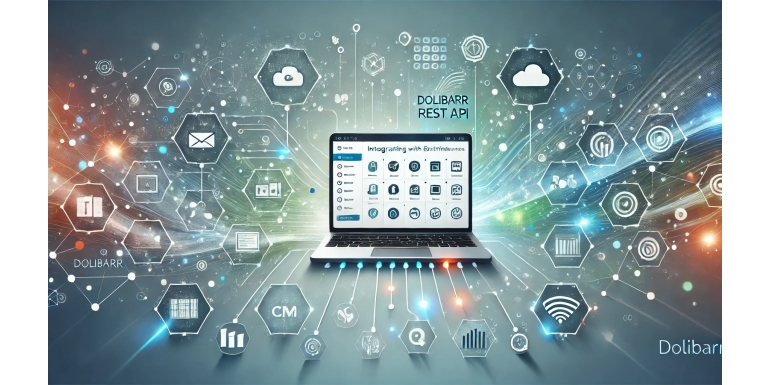
Dolibarr is an open-source ERP and CRM solution widely adopted for managing small and medium-sized businesses. Its modularity, flexibility, and active community make it a popular choice for companies seeking to efficiently manage their business processes. Among its most powerful features, the Dolibarr REST API plays a central role in integrating with external applications. This article explores in detail the key aspects of integrating Dolibarr with other tools via the REST API while offering practical tips for successful implementation.
What is Dolibarr and Why Use its REST API?
Dolibarr is an all-in-one platform that allows businesses to manage essential activities such as sales, inventory, invoicing, projects, and more. As free software, it is fully customizable to meet the specific needs of businesses.
The Dolibarr REST API offers an efficient and standardized way to connect the system to other applications, whether accounting software, e-commerce platforms, or project management tools. Here are some major advantages of using the REST API:
- Increased Interoperability: Facilitates data exchanges between different platforms.
- Process Automation: Reduces manual work through automated connections.
- Customization: Allows adapting Dolibarr to specific needs by integrating additional features.
- Operational Efficiency: Speeds up business processes through better communication between systems.
Basics of the Dolibarr REST API
The Dolibarr REST API is based on modern web standards that make integration easier. Before diving into the technical details, it’s essential to understand the fundamentals of this API.
Core Principles
- HTTP Protocol: The REST API uses HTTP requests (GET, POST, PUT, DELETE) to interact with Dolibarr.
- JSON Format: Data exchanged between systems is structured in JSON format, making it easy to read and manipulate.
- Authentication: The Dolibarr API supports multiple authentication methods, such as API keys and OAuth2.
Enabled Modules
To use the REST API, the relevant modules must be enabled in Dolibarr. For example:
- Activate the REST API module in the configuration menu.
- Ensure user permissions include access to the necessary resources.
Documentation
Dolibarr provides detailed documentation for its REST API, accessible via the admin interface. It contains sample requests, endpoint descriptions, and parameter explanations.
Steps to Integrate Dolibarr with External Applications
Integration via Dolibarr’s REST API can seem complex at first glance, but following a structured approach makes it more accessible. Here are the key steps to achieve successful integration.
1. Analyze Your Needs
Before starting, it’s crucial to identify the goals of the integration. Ask yourself:
- Which external application do you want to connect to Dolibarr?
- What types of data need to be exchanged (customers, products, orders, etc.)?
- What specific Dolibarr features will be used via the API?
2. Configure the API
Once the needs are defined, configure the API in Dolibarr:
- Go to the REST API module and activate it.
- Generate a unique API key for each external application.
- Configure permissions to restrict access to relevant resources.
3. Connect the External Application
Use the API endpoints to interact with Dolibarr. For example:
- To retrieve customer information, use the endpoint
/api/index.php/customers. - To create a new invoice, send a POST request to
/api/index.php/invoiceswith the required data.
4. Handle Errors and Logs
An essential part of integration involves managing errors. Ensure you check the API’s HTTP responses (codes 200, 400, 401, etc.) and set up logging to monitor potential issues.
Common Use Cases
1. Integration with an E-Commerce Website
Many businesses use Dolibarr alongside an online store like WooCommerce or Shopify. With the REST API, it’s possible to automatically synchronize products, inventory, and orders between Dolibarr and the store.
2. Connecting to Accounting Tools
Dolibarr’s REST API allows synchronization of invoices and transactions with accounting software like QuickBooks or Sage. This eliminates manual entry and ensures accurate financial data.
3. Automating Notifications
Dolibarr can be integrated with platforms like Slack or Microsoft Teams to send real-time notifications, such as when a new order is created or an invoice is validated.
4. Creating Custom Dashboards
Using tools like Power BI or Tableau, data from Dolibarr can be retrieved via the REST API to create advanced reports and dashboards, providing better visibility into business performance.
Best Practices for Successful Integration
1. Secure the API
Security is a priority when using the REST API. Here are some recommendations:
- Use robust API keys and change them regularly.
- Limit the permissions of API keys to avoid unauthorized access.
- Configure HTTPS access to encrypt data exchanges.
2. Test the Integrations
Before going live, test the API endpoints using tools like Postman. This ensures that integrations work as expected and reduces the risk of bugs.
3. Document the Processes
For easy maintenance, document all aspects of the integration, including the endpoints used, data flows, and custom scripts.
4. Optimize Performance
For optimal performance, avoid unnecessary requests and use data filtering via API parameters.
Common Challenges and Solutions
Integrating with Dolibarr can present some challenges, including:
- Data Complexity: The structure of Dolibarr’s data may require a deep understanding to avoid errors.
- Solution: Study the documentation and start with simple cases before progressing to more complex scenarios.
- API Limitations: While the REST API is powerful, it may have limitations for certain advanced use cases.
- Solution: Consider developing extensions or using custom scripts if necessary.
Conclusion
Integrating Dolibarr with external applications via the REST API unlocks a world of possibilities for automating processes and improving business efficiency. By following best practices, understanding the basics of the API, and carefully planning your project, you can transform your Dolibarr system into a central and interconnected platform.
Whether you’re new to integration or looking to explore specific use cases, don’t hesitate to rely on community resources, official documentation, or consult experts to maximize your project’s potential.
With Dolibarr, the future of business management is flexible, adaptable, and ready to evolve with your needs. Take full advantage of it with a successful integration via the REST API!
